This article was last updated in July 2019
You've seen the face-aging craze flying around social media. You may even have had a go and know how you'll look in 50 years' time.
From face-swapping to 3D filters, digital effects are accessible in a way like never before. But what are these deepfakes taking the internet by storm? How is this technology evolving, and what does Artificial Intelligence (AI) have to do with it?
In this Q&A, we ask Alan Zucconi, lecturer in AI and independent software developer, what's under the (artificial) skin of deepfakes.

Let's start with the basics: what is a deepfake?
If you are active on social media, you might have seen many apps and filters used to swap faces in pictures and videos. That technology has been around for many years, but has rarely produced believable results.
In 2017, a few posts emerged on Reddit, showing how it was possible to use Artificial Intelligence to seamlessly swap faces in videos. That technique was called deepfake. The 'deep' bit comes from Deep Learning, a branch of AI that uses something known as neural networks. In a nutshell, neural networks are a type of machine learning technique that bears some resemblance to how the human brain works.
Nowadays, there are several different ways to swap faces in a very realistic way. Not all use AI, but some do: deepfake is one of them.
The term deepfake is now generically used by the media to refer to any video in which faces have been either swapped or digitally altered, with the help of AI - a bit like how people use the brand names Kleenex or Hoover to refer to any tissue or vaccum cleaner.

How can you spot one?
The vast majority of deepfake videos available online are created by amateurs, and they are unlikely to fool anyone.
The process that creates deepfakes often leaves very visible artifacts around a person's face. Blurring or flickering, for example, are very common, especially when the face changes angles very rapidly.
Another common issue with deepfakes is that the eyes often move independently of each other. Deepfake videos tend to be rendered at a low resolution, which helps hide these issues.
That being said, there are many examples of videos that are virtually perfect, or that might seem real to the untrained eye.

How and why are they used?
The vast majority of deepfakes circulating the Internet are featuring celebrities and politicians - something that has worried many.
The process of creating a deepfake video requires many pictures of a person's face, which makes celebrities particularly vulnerable.
If we look more broadly at digital face editing, this is something that is heavily employed in the movie industry. Digital de-aging, for instance, is particularly popular: Samuel L. Jackson and Clark Gregg have been digitally de-aged by approximately 25 years in Captain Marvel.
Although with less success, it is often possible to 'digitally resurrect' late actors by reconstructing their appearance from scratch - this was the case of Peter Cushing, who appeared in the 2017 Star Wars installment Rogue One, despite having passed away in 1994.
While these applications are not technically classified as deepfakes, they are often presented as such in the media.
Studios, in fact, often rely on AI-based techniques to achieve those effects - although a lot of the work in the movie industry is still done manually.
Deepfakes have often been used to create pornographic content without the direct consent of the people involved.
It is very important to understand that that is not OK, even if the final result is not believable. Bullying does not need to be photo-realistic to be effective.

How are deepfakes evolving?
Many researchers are currently working to advance our understanding of AI, and how it can be used to edit videos and images. With these techniques becoming more accessible and reliable, it is not hard to imagine a future in which deepfakes will be just another tool in video editing programs.
It's likely AI will be featured heavily in the movie industry, slowly replacing makeup and costumes.
Deepfake-related technology could also be used in the near future to dub actors in other languages, as it happened in the video in which David Beckham delivered thanks to AI.
Both the gaming and fashion industries might also benefit from this, allowing players and customers to create custom avatars with their actual faces.
AI could also be used to help patients who are struggling to accept their body image, allowing them to see a version of their body they are more comfortable with.
There are so many positive ways in which deepfakes could be used to make our life better - and that is why this is a technology that needs to be understood, not just feared.
What does the future hold for deep fakes?
There has been a lot of discussion about deepfakes, and the political and legal implications they might have.
While waiting for legislators, many websites have already taken a stand against deepfakes. Some online platforms, for example, are actively trying to ban all non-consensual deepfake videos.
Other are worried that, without any proper regulations, many late actors and historical figures might be 'digitally resurrected' without the explicit consent of their relatives.
On the other hand, there is a fear that stricter rules might shine a bad light on deepfakes, which could slow down research in many fields related to AI.
But with technology getting better and better, we are heading for a future in which videos cannot be so easily trusted.
The best way to protect ourselves from fake news and misinformation is to refine our critical thinking skills.
Always be skeptical about the content that you see online, especially when it is designed to be shocking, sensationalistic or enraging. And before reposting something on social media, try double-checking its authenticity to reduce the spread of fake content - whether that is a video or a news article.
I want to make a deepfake for fun. What do I need to know and what should I consider when making one?
Creating a deepfake video is surprisingly easy, although is it a very tedious process! The technology is easy to understand, and anyone with a decent laptop and some basic understanding of programming can make their own.
Making a realistic, seamless deepfake videos, however, requires a much deeper knowledge and commitment.
If you are up for the challenge, there are two things that are absolutely necessary: a powerful GPU (graphics processing unit) and consent of the people in the footage and/or images you are manipulating.
Quiz: How well do you know these classic arcade games?
Can you get a High Score on this ultimate video arcade games quiz?

The 80s gadgets that were stranger things at the time
Walkmans, calculator watches and the greatest in video gaming

The games (and gamers) that made history
If you want to know who's making ┬Ż3 million playing video games, look no further.
